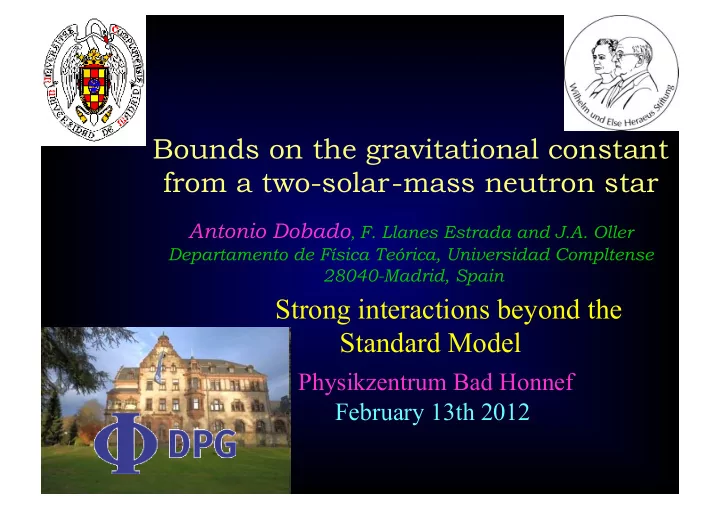

Bounds on the gravitational constant from a two-solar-mass neutron star Antonio Dobado , F. Llanes Estrada and J.A. Oller Departamento de Física Teórica, Universidad Compltense 28040-Madrid, Spain Strong interactions beyond the Standard Model Physikzentrum Bad Honnef February 13th 2012
Outline • Learning nuclear physics from gravity and the other way around by using massive pulsars
Neutron stars are the only window to part of the QCD phase diagram
The whole idea is based in the interpretation of the pulsars, discovered by Hewish in 1967, as neutron stars (Gold and others) Ciudad Real XXXII Bienal de Física (2009) 4
Neutron stars are believed to be the final states of massive stars which are not heavy enough to become black holes. In order to get some hystorical perspective... Let us take a tome machine a go back 110 years.... XXXII Bienal de Física (2009) 6
Neutrons stars are a natural lab for structure of matter Conjectures on the possibilty of exotic phases in the inner region Ciudad Real XXXII Bienal de Física (2009) 7
The motivation was the recent claim of the discovery of a two-solar- mass neutron star. Ciudad Real XXXII Bienal de Física (2009) 8
In contradicion with previous claims from the theoretical side
And almost all measured pulsar masses
But confirming a previous claim of neutron stars in this mass range
Radio timing observations of the binary millisecond second pulsar J1614-2230 show a strong Shapiro delay signature giving a pulsar mass of about 1.97 +/ - 0.04 solar mass. Demorest et al. 10.1038/nature 09466.
The theory of neutron stars started in 1939 with the seminal work by Oppenheimer-Volkoff and Tolman
Oppenheimer-Volkov-Tolman equation General relativistic hydrostatic equilibrium (spherical bodies) Important relativistic contributions Must be supplemented with the matter Equation of State (EoS) P=P ( ε ) Ciudad Real 14 XXXII Bienal de Física (2009)
Oppenheimer–Volkoff and Tolman plus the Equation of State allows the study of the equilibrium conditions for neutron stars Strong � Gravity Interaction
Therefore we have two possibilities: a) Assuming we know gravity we can learn about strong interactions (EoS). b) Assuming we know strong interactions we can learn about gravity (G N ).
Case a) Blue: Nucleons Pink: Nucleons plus exotic matter (kaons, hyperons…) Green: Strange quark matter
So we can rule out most of the exotic scenarios for the matter of neutron stars (quark matter, hyperons, kaon condensates) from the EoS in the maket, but perhaps strongly interacting quark matter (Demorest et all)
Case b) From a given EoS
We can get information about G N in an unexplored new regime (relativistic and high g) Ciudad Real XXXII Bienal de Física (2009) 20
G N Earth surface Ciudad Real XXXII Bienal de Física (2009) 21
This value is compatible with the ones found in other scenarios with much larger accelerations Earth surface J0737-3039 PSR B1913+16 (Hulse-Taylor) White darfs Ciudad Real PSR J1614-2230 (Demorest et al) XXXII Bienal de Física (2009) 22
This result may be relevant since many extensions of GR predict G N = G N (g) Ciudad Real XXXII Bienal de Física (2009) 23
Now we can extrapolate to the 1.97 solar-masses J1614-2230 pulsar assuming a given EoS.
For example the recently propossed based on Chiral Pertubation Theory which reproduces quite well the nuclear matter density from first principles (Chiral Symmetry and consistent momentum power counting in nuclear matter) Vr=1 Vr=1 Op5 Op6 Next � to � Leading Order Leading Order 2 1 ... Vr=2 Op6 3.1 Next � to � Leading Order ... 3.2 Lacour, Oller and Meissner 2009 Ciudad Real XXXII Bienal de Física (2009) 25
Solving Oppenheimer-Volkov-Tolman equation it is possible to find the acceleration profile for the two-solar-masses neutron star. PSR J1614-2230 XXXII Bienal de Física (2009)
Nuclear EoS supports at most 2.2 solar masses
Vary the Newton constant:
Variation of G N by more than 12% produce gravitational collapse upper bound on G N since there is a two-solar-masses neutron star
Setting a new upper bound on G N at large g. (12% of the Earth value at he 95% confidence level)
Summary and open questions • Pulsars are a very interesting laboratory to study the interplay between strong interactions and gravity in the General Relativistic regime. • The recent finding of a two-solar masses pulsar allows to rule out many models of strange nuclear matter and to set bounds on the variation of G N in a new regime of extremely high g (12 orders of magnitude the one on Earth). • This result can be usefull to set new constraints on modifications of GR such as f(R) or Lovelock theories of gravities. • Work is in progress in that direction.
Recommend
More recommend